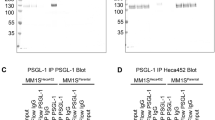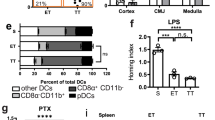Abstract
P-selectin glycoprotein ligand 1 (PSGL-1) is central to the trafficking of immune effector cells to areas of inflammation through direct interactions with P-selectin, E-selectin and L-selectin. Here we show that PSGL-1 was also required for efficient homing of resting T cells to secondary lymphoid organs but functioned independently of selectin binding. PSGL-1 mediated an enhanced chemotactic T cell response to the secondary lymphoid organ chemokines CCL21 and CCL19 but not to CXCL12 or to inflammatory chemokines. Our data show involvement of PSGL-1 in facilitating the entry of T cells into secondary lymphoid organs, thereby demonstrating the bifunctional nature of this molecule.
This is a preview of subscription content, access via your institution
Access options
Subscribe to this journal
Receive 12 print issues and online access
$209.00 per year
only $17.42 per issue
Buy this article
- Purchase on Springer Link
- Instant access to full article PDF
Prices may be subject to local taxes which are calculated during checkout







Similar content being viewed by others
References
von Andrian, U.H. & Mempel, T.R. Homing and cellular traffic in lymph nodes. Nat. Rev. Immunol. 3, 867–878 (2003).
Rosen, S.D. Ligands for L-selectin: homing, inflammation, and beyond. Annu. Rev. Immunol. 22, 129–156 (2004).
Miyasaka, M. & Tanaka, T. Lymphocyte trafficking across high endothelial venules: dogmas and enigmas. Nat. Rev. Immunol. 4, 360–370 (2004).
Forster, R. et al. CCR7 coordinates the primary immune response by establishing functional microenvironments in secondary lymphoid organs. Cell 99, 23–33 (1999).
Gunn, M.D. et al. Mice lacking expression of secondary lymphoid organ chemokine have defects in lymphocyte homing and dendritic cell localization. J. Exp. Med. 189, 451–460 (1999).
Weninger, W. & von Andrian, U.H. Chemokine regulation of naive T cell traffic in health and disease. Semin. Immunol. 15, 257–270 (2003).
Campbell, J.J. & Butcher, E.C. Chemokines in tissue-specific and microenvironment-specific lymphocyte homing. Curr. Opin. Immunol. 12, 336–341 (2000).
Lowe, J.B. Glycan-dependent leukocyte adhesion and recruitment in inflammation. Curr. Opin. Cell Biol. 15, 531–538 (2003).
Okada, T. et al. Chemokine requirements for B cell entry to lymph nodes and Peyer's patches. J. Exp. Med. 196, 65–75 (2002).
Tang, M.L., Steeber, D.A., Zhang, X.Q. & Tedder, T.F. Intrinsic differences in L-selectin expression levels affect T and B lymphocyte subset-specific recirculation pathways. J. Immunol. 160, 5113–5121 (1998).
Gauguet, J.M., Rosen, S.D., Marth, J.D. & von Andrian, U.H. Core 2 branching β1,6-N-acetylglucosaminyltransferase and high endothelial cell N-acetylglucosamine-6-sulfotransferase exert differential control over B- and T-lymphocyte homing to peripheral lymph nodes. Blood 104, 4104–4112 (2004).
Sackstein, R. The lymphocyte homing receptors: gatekeepers of the multistep paradigm. Curr. Opin. Hematol. 12, 444–450 (2005).
Ley, K. The role of selectins in inflammation and disease. Trends Mol. Med. 9, 263–268 (2003).
Rossi, F.M. et al. Recruitment of adult thymic progenitors is regulated by P-selectin and its ligand PSGL-1. Nat. Immunol. 6, 626–634 (2005).
Uchimura, K. et al. A major class of L-selectin ligands is eliminated in mice deficient in two sulfotransferases expressed in high endothelial venules. Nat. Immunol. 6, 1105–1113 (2005).
Kawashima, H. et al. N-acetylglucosamine-6-O-sulfotransferases 1 and 2 cooperatively control lymphocyte homing through L-selectin ligand biosynthesis in high endothelial venules. Nat. Immunol. 6, 1096–1104 (2005).
Ley, K. & Kansas, G.S. Selectins in T-cell recruitment to non-lymphoid tissues and sites of inflammation. Nat. Rev. Immunol. 4, 325–335 (2004).
Spertini, O., Cordey, A.S., Monai, N., Giuffre, L. & Schapira, M. P-selectin glycoprotein ligand 1 is a ligand for L-selectin on neutrophils, monocytes, and CD34+ hematopoietic progenitor cells. J. Cell Biol. 135, 523–531 (1996).
Martinez, M. et al. Regulation of PSGL-1 interactions with L-selectin, P-selectin, and E-selectin: role of human fucosyltransferase-IV and -VII. J. Biol. Chem. 280, 5378–5390 (2005).
Ellies, L.G. et al. Core 2 oligosaccharide biosynthesis distinguishes between selectin ligands essential for leukocyte homing and inflammation. Immunity 9, 881–890 (1998).
Pilkington, K.R., Clark-Lewis, I. & McColl, S.R. Inhibition of generation of cytotoxic T lymphocyte activity by a CCL19/macrophage inflammatory protein (MIP)-3β antagonist. J. Biol. Chem. 279, 40276–40282 (2004).
Hirata, T. et al. Human P-selectin glycoprotein ligand-1 (PSGL-1) interacts with the skin-associated chemokine CCL27 via sulfated tyrosines at the PSGL-1 amino terminus. J. Biol. Chem. 279, 51775–51782 (2004).
Fukuda, M. Leukosialin, a major O-glycan-containing sialoglycoprotein defining leukocyte differentiation and malignancy. Glycobiology 1, 347–356 (1991).
Baekkevold, E.S. et al. The CCR7 ligand elc (CCL19) is transcytosed in high endothelial venules and mediates T cell recruitment. J. Exp. Med. 193, 1105–1112 (2001).
Scimone, M.L. et al. CXCL12 mediates CCR7-independent homing of central memory cells, but not naive T cells, in peripheral lymph nodes. J. Exp. Med. 199, 1113–1120 (2004).
Yoshida, R. et al. Secondary lymphoid-tissue chemokine is a functional ligand for the CC chemokine receptor CCR7. J. Biol. Chem. 273, 7118–7122 (1998).
Hirose, J., Kawashima, H., Yoshie, O., Tashiro, K. & Miyasaka, M. Versican interacts with chemokines and modulates cellular responses. J. Biol. Chem. 276, 5228–5234 (2001).
Frenette, P.S. et al. P-Selectin glycoprotein ligand 1 (PSGL-1) is expressed on platelets and can mediate platelet-endothelial interactions in vivo. J. Exp. Med. 191, 1413–1422 (2000).
Loetscher, M. et al. Chemokine receptor specific for IP10 and mig: structure, function, and expression in activated T-lymphocytes. J. Exp. Med. 184, 963–969 (1996).
Willimann, K. et al. The chemokine SLC is expressed in T cell areas of lymph nodes and mucosal lymphoid tissues and attracts activated T cells via CCR7. Eur. J. Immunol. 28, 2025–2034 (1998).
Xia, L. et al. N-terminal residues in murine P-selectin glycoprotein ligand-1 required for binding to murine P-selectin. Blood 101, 552–559 (2003).
Li, F. et al. Visualization of P-selectin glycoprotein ligand-1 as a highly extended molecule and mapping of protein epitopes for monoclonal antibodies. J. Biol. Chem. 271, 6342–6348 (1996).
Moore, K.L. et al. P-selectin glycoprotein ligand-1 mediates rolling of human neutrophils on P-selectin. J. Cell Biol. 128, 661–671 (1995).
Hidari, K.I., Weyrich, A.S., Zimmerman, G.A. & McEver, R.P. Engagement of P-selectin glycoprotein ligand-1 enhances tyrosine phosphorylation and activates mitogen-activated protein kinases in human neutrophils. J. Biol. Chem. 272, 28750–28756 (1997).
Ba, X., Chen, C., Gao, Y. & Zeng, X. Signaling function of PSGL-1 in neutrophil: tyrosine-phosphorylation-dependent and c-Abl-involved alteration in the F-actin-based cytoskeleton. J. Cell. Biochem. 94, 365–373 (2005).
Galkina, E. et al. L-selectin shedding does not regulate constitutive T cell trafficking but controls the migration pathways of antigen-activated T lymphocytes. J. Exp. Med. 198, 1323–1335 (2003).
Rivera-Nieves, J. et al. Critical role of endothelial P-selectin glycoprotein ligand 1 in chronic murine ileitis. J. Exp. Med. 203, 907–917 (2006).
Hicks, A.E., Nolan, S.L., Ridger, V.C., Hellewell, P.G. & Norman, K.E. Recombinant P-selectin glycoprotein ligand-1 directly inhibits leukocyte rolling by all 3 selectins in vivo: complete inhibition of rolling is not required for anti-inflammatory effect. Blood 101, 3249–3256 (2003).
Sumariwalla, P.F., Malfait, A.M. & Feldmann, M. P-selectin glycoprotein ligand 1 therapy ameliorates established collagen-induced arthritis in DBA/1 mice partly through the suppression of tumour necrosis factor. Clin. Exp. Immunol. 136, 67–75 (2004).
Clark-Lewis, I., Mattioli, I., Gong, J.H. & Loetscher, P. Structure-function relationship between the human chemokine receptor CXCR3 and its ligands. J. Biol. Chem. 278, 289–295 (2003).
Carlow, D.A., Corbel, S.Y. & Ziltener, H.J. Absence of CD43 fails to alter T cell development and responsiveness. J. Immunol. 166, 256–261 (2001).
Bullard, D.C. et al. Infectious susceptibility and severe deficiency of leukocyte rolling and recruitment in E-selectin and P-selectin double mutant mice. J. Exp. Med. 183, 2329–2336 (1996).
Corbel, S.Y. et al. Contribution of hematopoietic stem cells to skeletal muscle. Nat. Med. 9, 1528–1532 (2003).
Merzaban, J.S., Zuccolo, J., Corbel, S.Y., Williams, M.J. & Ziltener, H.J. An alternate core 2 β1,6-N-acetylglucosaminyltransferase selectively contributes to P-selectin ligand formation in activated CD8 T cells. J. Immunol. 174, 4051–4059 (2005).
McLean, G.R., Nakouzi, A., Casadevall, A. & Green, N.S. Human and murine immunoglobulin expression vector cassettes. Mol. Immunol. 37, 837–845 (2000).
Drew, E., Merzaban, J.S., Seo, W., Ziltener, H.J. & McNagny, K.M. CD34 and CD43 inhibit mast cell adhesion and are required for optimal mast cell reconstitution. Immunity 22, 43–57 (2005).
Acknowledgements
We thank R. Beavis for discussions; K.M. McNagny for critically reading the manuscript; P.D. Ziltener and M.J. Ford for technical assistance; J. Marth (University of California at San Diego) for C2GlcNAcT-1-deficient mice; D.C. Bullard (University of Alabama) for E-selectin-deficient mice; I. Weissman (Stanford University) for mice expressing GFP; G. McLean (University of Texas Health Sciences Center at Houston) for the vector encoding for human IgG1; and F. Melchers (Basel Institute of Immunology) for myeloma X.653 cells transfected with cDNA encoding mouse IL-2. Supported by the National Institutes of Health (R01GM57411 and R01GM23547 to S.D.R.), the Canadian Institutes for Health Research (J.S.M.; MOP-64267 and MOP-77552 to H.J.Z.) and Deutsche Forschungsgemeinschaft (S.N.)
Author information
Authors and Affiliations
Contributions
J.S.M., H.J.Z. and K.U., S.D.R. independently discovered the PSGL-1 requirement for T cell homing; K.M.V. did the competitive homing assays; K.U. and M.S.S. did the mAb inhibition homing assays; M.J.W. designed and did the chemotaxis and CCL21 binding assays; S.N. contributed to the CCL21 binding studies; D.A.C. contributed to the experimental design of the competitive in vivo and in vitro studies; P.O. produced all chemokines; J.R.-N. provided anti-PSGL-1 and helped with the inhibition studies; H.J.Z. and S.D.R. supervised research and coordinated ongoing work; K.M.V. and H.J.Z. wrote the first draft of the manuscript; and all authors contributed to discussions and preparation of the manuscript.
Corresponding author
Ethics declarations
Competing interests
The authors declare no competing financial interests.
Supplementary information
Supplementary Fig. 1
SLO homing and chemotactic migration rates are not influenced by fluorescent labeling of lymphocytes. (PDF 11 kb)
Supplementary Fig. 2
The PSGL-1 influence on homing of lymphocytes to SLO is independent of C2GlcNAcT-I. (PDF 12 kb)
Supplementary Fig. 3
CD4+ and CD8+ T cells express more PSGL-1 than B220+ B cells. (PDF 24 kb)
Supplementary Fig. 4
Sodium azide blocks CCL21 internalization but diminishes the degree of PSGL-1 dependent CCL21 binding. (PDF 18 kb)
Supplementary Table 1
Raw data collected and used to calculate the differences in homing between anti-PSGL-1 mAb treated and IgG1 control treated lymphocytes. (PDF 8 kb)
Supplementary Table 2
Raw data collected and used to calculate the differences in homing between PSGL-1 knockout and WT lymphocytes. (PDF 12 kb)
Supplementary Table 3
Raw data collected and used to calculate the differences in homing between PSGL-1 knockout and WT lymphocytes. (PDF 9 kb)
Rights and permissions
About this article
Cite this article
Veerman, K., Williams, M., Uchimura, K. et al. Interaction of the selectin ligand PSGL-1 with chemokines CCL21 and CCL19 facilitates efficient homing of T cells to secondary lymphoid organs. Nat Immunol 8, 532–539 (2007). https://doi.org/10.1038/ni1456
Received:
Accepted:
Published:
Issue Date:
DOI: https://doi.org/10.1038/ni1456
This article is cited by
-
VISTA and its ligands: the next generation of promising therapeutic targets in immunotherapy
Cancer Cell International (2023)
-
“Stuck on sugars – how carbohydrates regulate cell adhesion, recognition, and signaling”
Glycoconjugate Journal (2019)
-
Extrafollicular CD4+ T-B interactions are sufficient for inducing autoimmune-like chronic graft-versus-host disease
Nature Communications (2017)
-
Distinct gene expression patterns correlate with developmental and functional traits of iNKT subsets
Nature Communications (2016)
-
RUNX1/ETO blocks selectin-mediated adhesion via epigenetic silencing of PSGL-1
Oncogenesis (2015)



